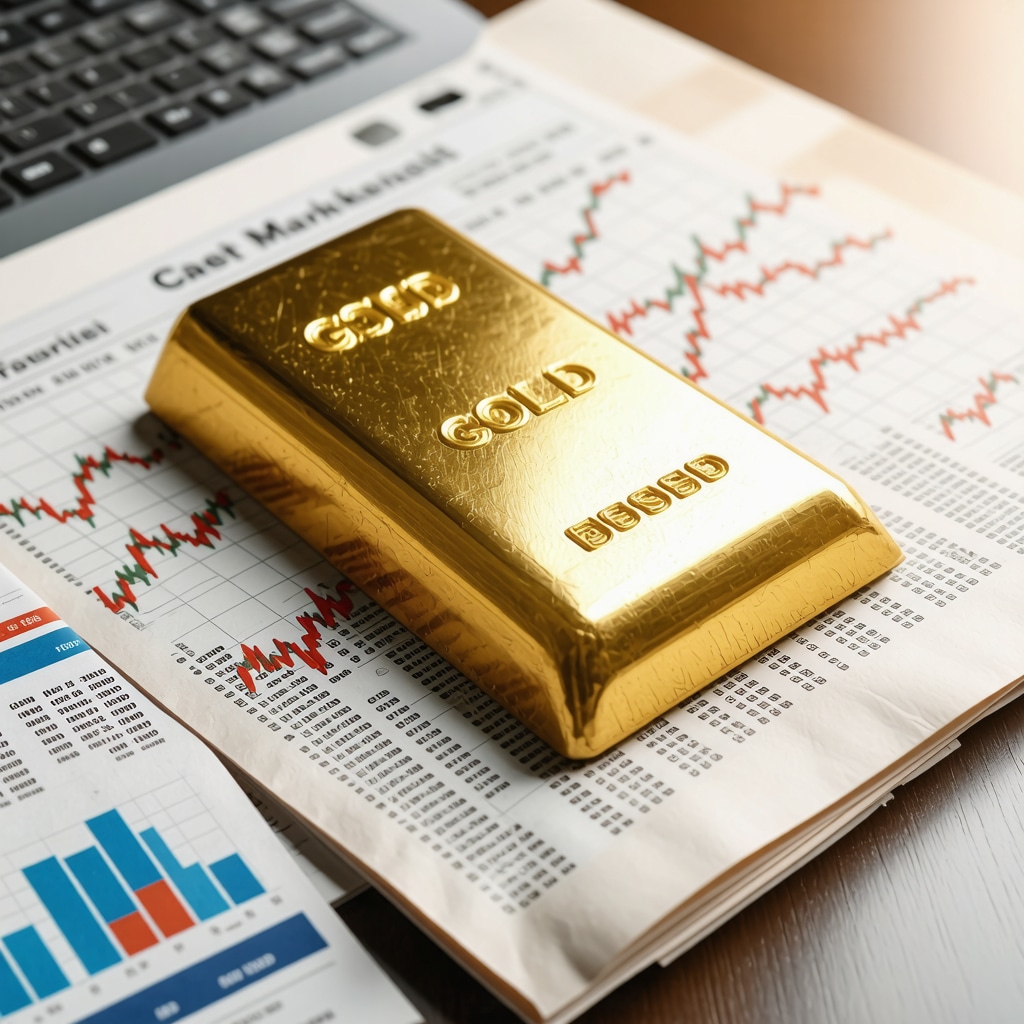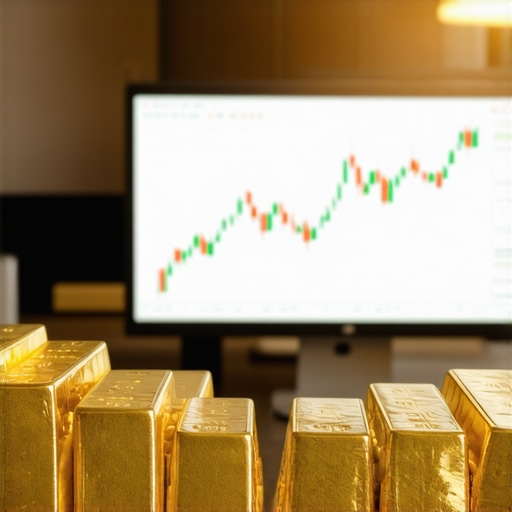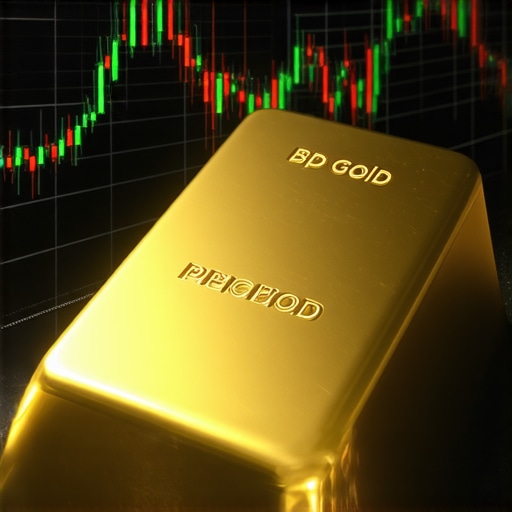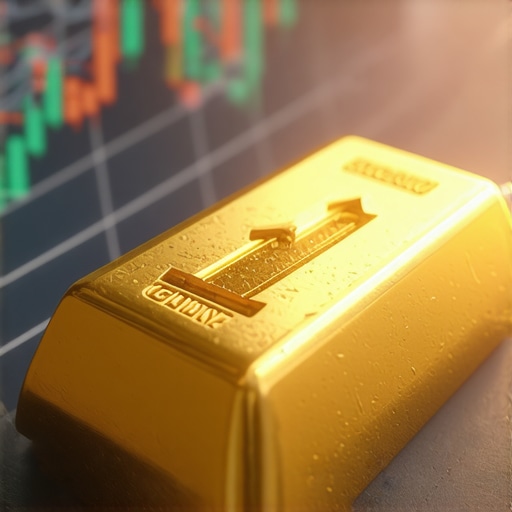Decoding the Glittering Future: Why 2025 Could Be a Pivotal Year for Gold Prices
As investors worldwide meticulously strategize for the coming years, the spotlight increasingly falls on gold—a timeless asset known for its resilience and intrinsic value. The gold price forecast 2025 draws keen interest not only from seasoned traders but also from cautious newcomers seeking refuge amid economic unpredictability. Understanding what lies ahead requires a nuanced examination of market dynamics, geopolitical shifts, and inflationary trends that collectively sculpt gold’s trajectory.
Global Economic Currents: Navigating Inflation and Monetary Policies Impacting Gold
Inflation remains a chief catalyst driving gold prices. With central banks adjusting interest rates to combat inflationary pressures, gold traditionally benefits as a hedge against currency devaluation. Particularly, the Federal Reserve’s monetary policy decisions play a significant role; a dovish stance tends to elevate gold’s appeal. Moreover, geopolitical tensions and supply chain disruptions amplify investors’ flight to safety, often boosting demand for physical gold and gold-backed assets.
How Do Central Bank Gold Purchases Influence the 2025 Price Outlook?
Central banks globally have resumed substantial gold acquisitions, reflecting a strategic pivot to diversify reserves beyond fiat currencies. This trend fortifies gold’s price floor by tightening supply and signaling confidence in gold as a store of value. For example, according to the World Gold Council, central bank purchases reached a multi-year high in recent quarters, a momentum expected to persist into 2025. Such institutional demand can act as a stabilizing force amid volatile equity markets, underscoring gold’s enduring role in portfolio diversification.
Investor Strategies: Balancing Physical Gold and Financial Instruments
Investors contemplating the gold price forecast 2025 should consider a balanced allocation across physical bullion, ETFs, and futures. Physical gold offers tangible security but entails storage considerations, whereas gold ETFs provide liquidity and ease of trading. Futures and options can amplify gains but demand sophisticated risk management. Seasoned investors often blend these instruments to optimize portfolio resilience and capitalize on anticipated price movements.
Emerging Market Demand: The Silent Force Behind Gold’s Momentum
Beyond institutional buying, consumer demand from emerging markets such as India and China remains a potent driver. Cultural affinity for gold jewelry and investment coins sustains consistent demand, especially during festivals and weddings. Economic growth in these regions predicates rising disposable incomes, which could sustain or elevate gold consumption. Monitoring these demand trends offers investors a critical lens into underlying market strength that technical analysis alone might overlook.
Seeking Clarity Amid Complexity: Where Can Investors Deepen Their Gold Market Insights?
For those eager to sharpen their understanding of gold price fluctuations and strategic positioning, detailed market analyses and trading techniques are invaluable. Resources like how to analyze gold market fluctuations for smarter trades provide expert methodologies to interpret market signals and optimize trade timing.
We invite you to share your thoughts or questions about navigating gold investments in 2025—engage with our community to refine your strategy and capitalize on emerging opportunities.
For authoritative insights into gold’s economic role and historic performance, consider consulting publications by the World Gold Council, a globally recognized authority on gold market data and trends.
Central Bank Strategies: Beyond Purchases, How Do Reserves Affect Gold Liquidity?
While central bank gold purchases have garnered attention, an equally critical yet nuanced aspect is how these reserves influence market liquidity and price volatility. Central banks hold gold not just as a static asset but as a dynamic reserve that can be leveraged in various monetary operations. For instance, gold leasing programs and swaps can increase short-term supply in the market, potentially tempering price spikes. Conversely, prolonged accumulation of physical gold by sovereign entities restricts available supply, tightening market conditions. Understanding these mechanisms helps investors anticipate gold price swings beyond surface-level demand metrics.
Technological Innovation and Gold Trading: The Rise of Algorithmic and AI-Driven Strategies
Advancements in trading technology have transformed the gold market landscape, introducing algorithmic and AI-driven strategies that analyze vast datasets for predictive insights. These technologies can detect subtle correlations between macroeconomic indicators and gold price movements, enabling sophisticated traders to position advantageously. However, such innovation also introduces heightened competition and volatility, as rapid automated trades can trigger sharp price fluctuations. For investors, keeping abreast of these evolving trading methodologies is crucial for effective risk management and seizing time-sensitive opportunities.
What Are the Practical Implications of Emerging Gold Trading Technologies for Portfolio Management?
From an expert perspective, integrating knowledge of advanced trading technologies into portfolio management means balancing traditional investment wisdom with data-driven agility. Investors must refine their strategies to incorporate signals generated by AI models while maintaining diversification to buffer against algorithmic market shocks. Additionally, leveraging platforms that offer real-time analytics and automated alerts can enhance decision-making efficiency. This hybrid approach not only mitigates risk but also positions portfolios to capitalize on transient market inefficiencies that human analysis alone might miss.
Decoding Consumer Behavior: How Cultural Nuances Shape Gold Demand in Emerging Markets
Emerging markets present a complex mosaic of cultural, economic, and social drivers behind gold demand. For example, in India, gold is deeply intertwined with matrimonial customs and religious ceremonies, creating predictable seasonal demand peaks. In China, the growing middle class increasingly views gold as both a wealth preservation tool and a status symbol, influencing urban consumption patterns distinct from rural areas. Recognizing these subtle yet impactful nuances allows investors to forecast demand cycles more accurately, especially when combined with macroeconomic indicators such as GDP growth and currency trends.
Expert Analysis and Credible Resources to Elevate Your Gold Investment Acumen
Investors seeking authoritative insights should explore comprehensive reports and data analyses provided by the World Gold Council, a renowned institution offering granular market intelligence and trend forecasts. Their research delves into supply-demand dynamics, investor sentiment, and geopolitical influences shaping gold prices. Additionally, subscribing to platforms specializing in precious metals analytics can provide actionable trade strategies and risk assessment tools.
For a deeper dive into how gold market fluctuations can be effectively analyzed to maximize trade outcomes, consider reading how to analyze gold market fluctuations for smarter trades. This resource equips investors with practical frameworks to interpret complex market signals.
Engage with our community by sharing your questions or insights on emerging gold market trends—your experiences can help refine collective strategies for 2025 and beyond.
Central Bank Reserves and Gold Liquidity: The Hidden Dynamics Shaping Market Volatility
While central bank acquisitions of gold often headline market narratives, the underlying liquidity mechanisms tied to these reserves warrant deeper scrutiny for advanced investors. Central banks don’t merely hoard gold as a static asset; they actively manage these reserves through leasing programs, swap agreements, and collateralized transactions that modulate short-term supply in global markets. For instance, gold leasing allows bullion banks and trading institutions to borrow gold at a cost, temporarily increasing market availability and potentially alleviating upward price pressure during spikes. Conversely, when central banks reduce leasing or withdraw gold from these channels, the effective supply tightens, often triggering sharper price movements.
Understanding the interplay between central bank reserve management and gold market liquidity enhances an investor’s ability to anticipate volatility beyond conventional supply-demand analyses. Notably, the International Monetary Fund’s reports on gold reserves provide granular data on sovereign gold holdings and leasing activity, offering valuable insights into potential supply shifts that may impact price trajectories in 2025.
Algorithmic and AI-Driven Gold Trading: Revolutionizing Market Efficiency and Risk
The gold market is increasingly influenced by algorithmic and artificial intelligence (AI) trading strategies that process vast, multidimensional datasets encompassing economic indicators, geopolitical events, and even social media sentiment. These technologies enable hyper-responsive trading, exploiting transient inefficiencies and correlations invisible to traditional analysis. However, this evolution also introduces novel risks: algorithmic feedback loops can amplify price swings, and AI models may misinterpret anomalous data, resulting in flash crashes or rapid corrections.
How Should Investors Adapt Portfolio Management to the Rise of AI-Driven Gold Trading?
Expert portfolio managers recognize that integrating AI-driven insights demands a hybrid approach blending quantitative agility with fundamental analysis. Investors should leverage platforms offering real-time, AI-powered analytics and automated alerts to detect early market shifts while maintaining diversified holdings across physical gold, ETFs, and derivatives to buffer algorithmic volatility. Moreover, scenario analysis incorporating AI-generated stress tests can refine risk mitigation strategies, ensuring portfolios remain resilient amid sudden market dislocations triggered by automated trading.
Decoding Cultural Complexities: The Microeconomic Drivers Behind Emerging Market Gold Demand
Emerging markets’ gold demand transcends mere economic growth metrics, deeply embedded within cultural traditions, social status cues, and evolving consumer behaviors. In India, for example, gold’s role in matrimonial wealth transfers creates cyclical demand surges aligned with festival seasons and wedding calendars, which can be anticipated with remarkable precision. Meanwhile, China’s urbanization and rising affluence have shifted gold consumption towards investment-grade products and digital platforms, reflecting a nuanced transition from ornamental to financial asset demand.
These microeconomic factors, when combined with macroeconomic indicators such as currency stability and inflation rates, form a sophisticated demand matrix that investors must decode to accurately forecast gold price movements. Ignoring these cultural subtleties risks oversimplifying demand projections and missing critical inflection points in the gold market.

Advanced Resources for Gold Market Mastery: Elevate Your Analytical Framework
To navigate the complex gold market landscape in 2025, investors should engage with specialized research institutions and data analytics platforms. The World Gold Council’s research division offers comprehensive studies on supply-demand dynamics, investor behavior, and geopolitical impacts, supported by robust statistical methodologies. Additionally, platforms providing AI-enhanced market intelligence and trading simulations can sharpen decision-making and risk assessment capabilities.
We encourage you to delve deeper into these expert resources and participate in discussions within our community to refine your investment strategies amid evolving gold market paradigms.
Unveiling Macroprudential Factors: The Intersection of Fiscal Policies and Gold Price Trajectories
Beyond central bank maneuvers, sovereign fiscal policies significantly influence gold price dynamics, especially as governments grapple with burgeoning debt levels and shifting budgetary priorities. Expansionary fiscal measures often stoke inflationary pressures, indirectly bolstering gold’s appeal as an inflation hedge. Conversely, austerity policies may dampen economic growth, prompting risk aversion and increasing safe-haven demand for gold. For investors, dissecting fiscal trends alongside monetary policies provides a more holistic understanding of potential gold price inflection points in 2025.
Integrating ESG Considerations in Gold Investment: The Rising Importance of Sustainable Sourcing
As Environmental, Social, and Governance (ESG) criteria gain prominence among institutional and retail investors, the gold market is undergoing a paradigm shift. Ethical sourcing, transparency in mining practices, and carbon footprint reductions are increasingly factored into investment decisions. Gold producers embracing sustainable practices can command premium valuations, influencing supply dynamics and investor preference. Incorporating ESG metrics into portfolio evaluations not only aligns with responsible investing principles but also mitigates regulatory and reputational risks associated with traditional gold mining.
How Can Advanced Investors Leverage ESG Trends to Optimize Gold Portfolio Performance?
Discerning investors are advised to integrate ESG analytics tools and sustainability reports from leading gold mining companies to identify assets with lower environmental impact and stronger governance frameworks. This approach may reduce exposure to regulatory volatility and enhance long-term returns through alignment with evolving market preferences. Additionally, engagement with certified responsible gold initiatives, such as the Responsible Jewellery Council, can provide confidence in investment integrity. Employing ESG filters alongside traditional valuation metrics offers a sophisticated strategy to capture emerging alpha in the gold sector.
Harnessing Geopolitical Analytics: Predictive Modeling for Gold Price Volatility
Geopolitical risk remains a perennial driver of gold price volatility, but recent advancements in predictive analytics enable a more nuanced risk assessment. By leveraging machine learning algorithms to analyze geopolitical event datasets, investors can forecast potential market shocks and preemptively adjust positions. Scenarios such as trade disputes, sanctions, and regional conflicts have quantifiable impacts on gold demand as a crisis asset. Integrating these predictive tools into risk management frameworks enhances portfolio resilience and capitalizes on short- to medium-term price dislocations.
Augmenting Your Gold Investment Toolkit: Where to Access Cutting-Edge Data and Analytical Platforms
Expert investors seeking to refine their gold market acumen should explore platforms like Refinitiv’s commodities data service, which offers real-time pricing, sentiment analysis, and comprehensive geopolitical risk indices tailored for precious metals. These tools complement traditional sources such as the World Gold Council, providing multidimensional datasets essential for advanced market analysis.
We invite you to deepen your engagement with these advanced gold market insights—share your strategies and questions to foster a community of high-caliber investors prepared for the complexities of 2025 and beyond.
Frequently Asked Questions (FAQ)
What factors primarily influence the gold price forecast for 2025?
The 2025 gold price forecast is shaped by a confluence of factors including central bank monetary policies, inflation trends, geopolitical tensions, emerging market demand, and fiscal measures. Additionally, market liquidity influenced by central bank reserve management, technological advances in trading, and ESG considerations play critical roles in determining gold’s trajectory.
How do central bank gold purchases impact market prices and liquidity?
Central bank purchases strengthen gold prices by reducing available supply and signaling confidence in gold as a reserve asset. However, central banks also manage liquidity through leasing and swaps, temporarily increasing supply to moderate price spikes. These dynamics create complex volatility patterns that investors must monitor beyond simple purchase volumes.
What is the significance of emerging market demand in the 2025 outlook?
Emerging markets like India and China drive robust consumer demand due to cultural traditions, rising incomes, and evolving investment preferences. Seasonal events, urbanization, and shifts from ornamental to investment-grade gold influence demand cycles, making these markets critical barometers for global gold consumption and price movements.
How are technological innovations changing gold trading strategies?
Algorithmic and AI-driven trading strategies analyze vast datasets to identify market inefficiencies and predict price movements. While they enhance market efficiency and create new opportunities, they also increase volatility and require investors to adopt agile portfolio management approaches combining quantitative insights with traditional fundamentals.
In what ways do ESG considerations affect gold investments?
ESG factors influence gold markets by elevating demand for sustainably sourced and ethically produced gold. Investors increasingly prefer mining companies with strong environmental and governance practices, which can yield premium valuations and reduce regulatory risks. Integrating ESG analytics refines portfolio risk profiles and aligns investments with evolving market values.
How can investors balance physical gold and financial instruments effectively?
A diversified approach that combines physical bullion for tangible security with ETFs and derivatives for liquidity and leverage is optimal. Physical gold requires storage considerations, while ETFs and futures offer trading flexibility but demand advanced risk management. A hybrid strategy enhances resilience and capitalizes on varied market conditions.
What role do sovereign fiscal policies play in gold price dynamics?
Sovereign fiscal policies, such as expansionary spending or austerity, influence inflation and economic growth, which in turn affect gold’s appeal as a safe haven and inflation hedge. Evaluating fiscal trends alongside monetary policy provides a comprehensive lens to anticipate price inflection points.
How can predictive geopolitical analytics improve gold investment decisions?
Machine learning models analyzing geopolitical events allow investors to forecast market shocks and adjust positions proactively. Incorporating these predictive insights into risk management enhances portfolio resilience and enables capitalization on crisis-driven price volatility.
Where can investors access authoritative data and research on gold markets?
Leading sources include the World Gold Council for comprehensive market intelligence, the International Monetary Fund for sovereign gold reserve data, and specialized platforms like Refinitiv for real-time commodities pricing and geopolitical risk indices. These resources support sophisticated analysis and informed decision-making.
What strategies should investors adopt amid increasing algorithmic trading volatility?
Investors should adopt hybrid portfolio management that leverages AI analytics for timely insights while maintaining diversified holdings to mitigate algorithm-driven market swings. Scenario analysis and stress testing informed by AI-generated models further enhance risk mitigation in volatile environments.
Trusted External Sources
- World Gold Council (gold.org): The premier authority on gold market data, supply-demand analysis, and trend forecasts offering in-depth research crucial for understanding global gold dynamics.
- International Monetary Fund (IMF) (imf.org): Provides detailed data on sovereign gold reserves, leasing programs, and liquidity mechanisms that influence market supply and price volatility.
- Refinitiv Commodities Data Service (refinitiv.com): Offers real-time pricing, sentiment analytics, and geopolitical risk indices essential for advanced market analysis and trading strategies.
- Responsible Jewellery Council (responsiblejewellery.com): A key resource for standards on ethical gold sourcing and sustainability practices impacting ESG-conscious investing.
- Specialized Precious Metals Analytics Platforms: Subscription-based services that provide AI-enhanced market intelligence, trading simulations, and risk assessment tools to sharpen investor decision-making.
Conclusion
Navigating the gold price forecast for 2025 demands a multifaceted understanding of macroeconomic trends, geopolitical uncertainties, technological advancements, and cultural market drivers. Central bank activities, emerging market consumption, and evolving ESG standards intricately weave into gold’s valuation landscape. Moreover, the rise of algorithmic and AI-driven trading reshapes market behavior, compelling investors to adopt agile, data-informed strategies balanced with fundamental analysis. By leveraging authoritative research and integrating predictive analytics, investors can better anticipate price volatility and capitalize on opportunities in the complex gold market of 2025. We encourage you to apply these expert insights, engage with our community for shared knowledge, and continue exploring related content to enhance your gold investment acumen for a resilient and informed portfolio journey ahead.










